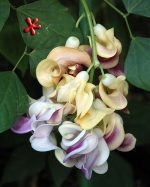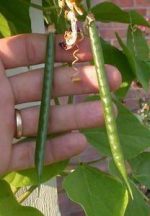 Native to southern Mexico, Central America and tropical South America this tender perennial, twining vine is also known as corkscrew vine, snail creeper, snailflower and snail bean. It is a member of the pea family, Fabaceae, that also includes beans, lupines, and black locusts. The vines rapidly grow to 10-20 ‘ long and have a tuberous root system and trifoliate leaves that are glossy dark green and have pointed tips. From summer to early fall, 12″ long pendant clusters of white buds appear and open to fragrant, 1-2″ white flowers that are white streaked with pale purple, maturing to light yellow and maroon. The petals are curled and resemble snails. The flowers have a strong fragrance that is often compared to that of hyacinth, jasmine, wisteria, and lily, and are attractive to bees and butterflies. The fruit is a long slender bean pod that matures in later fall. The genus name, Cochliasanthus, comes from the Greek word kokhlias meaing snail shell, and refers to the appearance of the flowers. The specific epithet, caracalla, is thought to be a corruption of the Portuguese word caracol, meaning snail. Photo Credit Wikipedia
Native to southern Mexico, Central America and tropical South America this tender perennial, twining vine is also known as corkscrew vine, snail creeper, snailflower and snail bean. It is a member of the pea family, Fabaceae, that also includes beans, lupines, and black locusts. The vines rapidly grow to 10-20 ‘ long and have a tuberous root system and trifoliate leaves that are glossy dark green and have pointed tips. From summer to early fall, 12″ long pendant clusters of white buds appear and open to fragrant, 1-2″ white flowers that are white streaked with pale purple, maturing to light yellow and maroon. The petals are curled and resemble snails. The flowers have a strong fragrance that is often compared to that of hyacinth, jasmine, wisteria, and lily, and are attractive to bees and butterflies. The fruit is a long slender bean pod that matures in later fall. The genus name, Cochliasanthus, comes from the Greek word kokhlias meaing snail shell, and refers to the appearance of the flowers. The specific epithet, caracalla, is thought to be a corruption of the Portuguese word caracol, meaning snail. Photo Credit Wikipedia
 Type: Tender perennial twining vine
Type: Tender perennial twining vine
Bloom: Clusters of highly fragrant snail-like white flowers streaked with pale purple, maturing to light yellow and maroon from summer into early fall.
Size: 10-20′ long
Light: Full sun to partial shade
Soil: Fertile, consistantly moist, well-drained, neutral to slightly acidic
Hardiness: Zones 9-11
Care: Plant in an area that is protected from wind and changes in temperature. Prune lightly where grown as an annual; remove old stems before regrowth where grown as a perennial. In USDA Hardiness Zones 8 and colder, plant in containers, cut to the soil level, bring indoors,and place in bright light during cool weather.
Pests and Diseases: Generally healthy; the plants need ants for fertilization so protect them.
Propagation: Seed, cuttings
Photo Credit: Dave Whitinger Wikipedia